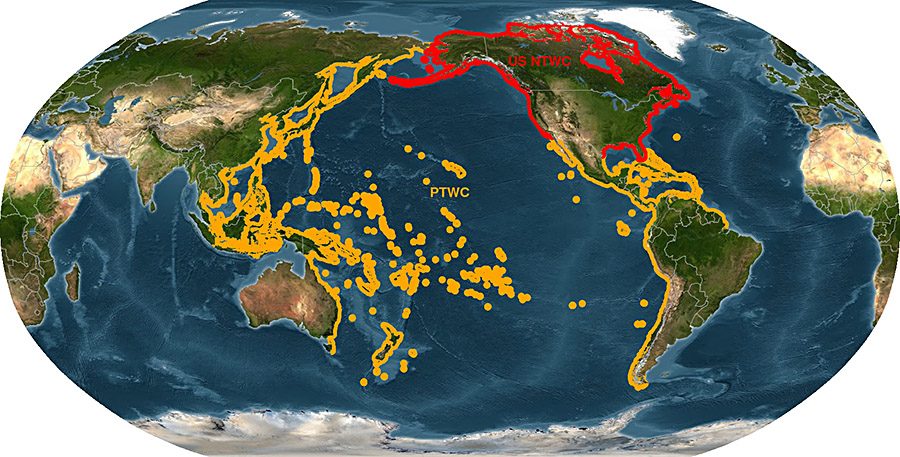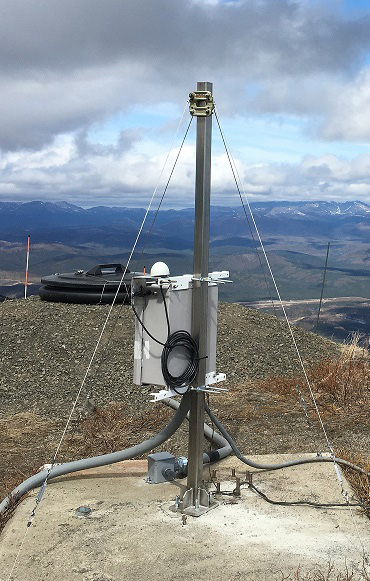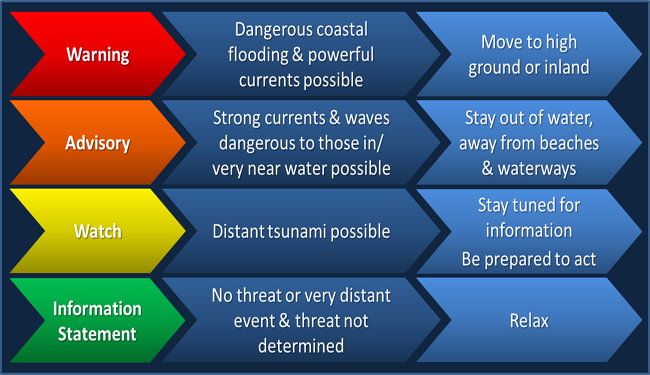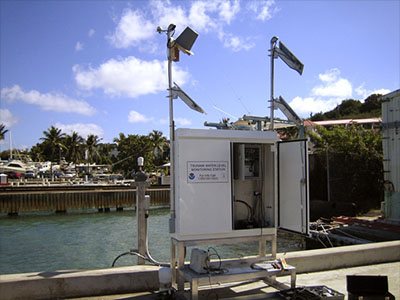Tsunami Warning Centers
A tsunami warning center is a vital part of a tsunami warning system. They have been established around the world with the primary goal of saving lives.
Most were created following large tsunamis that raised concern about the hazard, both on affected shores and beyond. A number of new warning centers became operational following the 2004 Indian Ocean tsunami.
Because tsunamis are a global problem, these centers operate in cooperation with international partners and as part of international warning systems offsite link.

In the United States, tsunami warning centers are part of a larger tsunami warning system that aims to minimize the impacts of tsunamis. Operated by the National Oceanic and Atmospheric Administration (NOAA), two tsunami warning centers are staffed 24 hours a day, 7 days a week. These centers monitor for tsunamis and the earthquakes that cause them, forecast tsunami impacts, and prepare and issue tsunami messages.
-
The Pacific Tsunami Warning Center (PTWC) in Hawaii was established following a 1946 tsunami that struck Hawaii, killing more than 150 people and causing over $300 million in damage (2017 dollars). The PTWC provides tsunami messages for the Hawaiian Islands, the U.S. Pacific and Caribbean territories, and the British Virgin Islands.
It also provides forecast information to international partners in the Pacific and Caribbean and adjacent regions to help them understand the threat to their coasts so they can decide whether or not to issue alerts.
-
The National Tsunami Warning Center (NTWC) in Alaska was established after the largest recorded earthquake in U.S. history generated a number of destructive tsunamis in 1964. These tsunamis killed 124 people in Alaska, Oregon, and California and caused approximately $1 billion (2017 dollars) in damage.
The NTWC provides tsunami messages for the continental United States, Alaska, and Canada.
Detecting Tsunamis and Issuing Messages
Like the earthquakes that generate most tsunamis, scientists cannot predict when and where the next tsunami will strike. But based on their knowledge of earthquakes and past tsunamis, scientists at the tsunami warning centers know which earthquakes are likely to generate tsunamis and can issue tsunami messages when they think a tsunami is possible.
To provide timely, reliable, and accurate tsunami warnings and forecasts, warning center scientists must be able to quickly detect and analyze earthquakes and observe and measure tsunamis.
To do this, they depend on information about earthquakes and tsunamis collected from seismic and water-level networks from around the world.
"Seismic" means relating to earthquakes. Seismic networks consist of seismic stations that detect, measure, and record earthquakes (and other types of ground motion) and transmit information to the warning centers in real time through satellites and other systems.
Seismic waves travel about 100 times faster than tsunamis, so information about an earthquake is available before information about any tsunami it may have generated.
Since a tsunami can strike nearby coasts within minutes, warning center scientists use an earthquake's preliminary seismic information (magnitude, location, and depth) to decide if an earthquake could have generated a tsunami and if they should issue an initial tsunami message.
For U.S. and Canadian coasts, warning center scientists are typically able to issue initial messages within five minutes of an earthquake. These messages provide alert levels (warning, advisory, watch, information statement), preliminary information about the earthquake, and an evaluation of the threat.



If a tsunami is suspected, messages may also include wave arrival times, recommended actions, and potential impacts. These messages are sent through multiple channels to emergency managers, other officials, news media, and the public.
Messages are updated regularly throughout an event as information becomes available.
If the warning center scientists decide a tsunami is possible, they monitor information from water-level networks to determine the existence and size of a tsunami and to verify, adjust, or cancel messages.
NOAA established and maintains two essential water-level networks that send information about water-level height to the warning centers by satellite, the Internet, and private circuits:
-
Deep-ocean Assessment and Reporting of Tsunami (DART) systems: A network of DART systems supports the early detection, measurement, and real-time reporting of tsunamis in the deep ocean. DART systems measure passing tsunamis by sensing pressure changes at the bottom of the ocean (as water depth increases, pressure increases).
The U.S. network, part of a larger international network, consists of 39 DART systems located throughout the Pacific and Atlantic Oceans, the Gulf of Mexico, and the Caribbean Sea.
Take it to the MAX! Deep-ocean Assessment and Reporting of Tsunami
- Coastal water-level stations: An extensive network of water-level stations near the coast, generally on piers in harbors, measures the height of the ocean at specific locations. Their primary purpose is to monitor tides for navigation purposes, but they are also used to confirm tsunami arrival time and height.

The time it takes to detect a tsunami depends on the distance between its source and the nearest DART system or coastal water-level station. Normal time frames range from five minutes to two hours.
Forecasting Tsunamis
If a tsunami is detected, the warning center scientists run tsunami forecast models using real-time information from the seismic and water-level networks, preset scenarios, bathymetry, and topography to show how the tsunami will move across the ocean and to estimate impacts at specific coastal locations. Impact information includes wave height and arrival times, location and extent of coastal flooding, and how long the tsunami will last.
The resulting forecasts, combined with historical tsunami information and additional seismic analysis, help the warning center scientists make decisions about adjusting and cancelling messages.
These forecasts are included in updated tsunami messages and provide local officials with information that can guide decisions about evacuation, including pedestrian and traffic routes, and beach and road closures.


